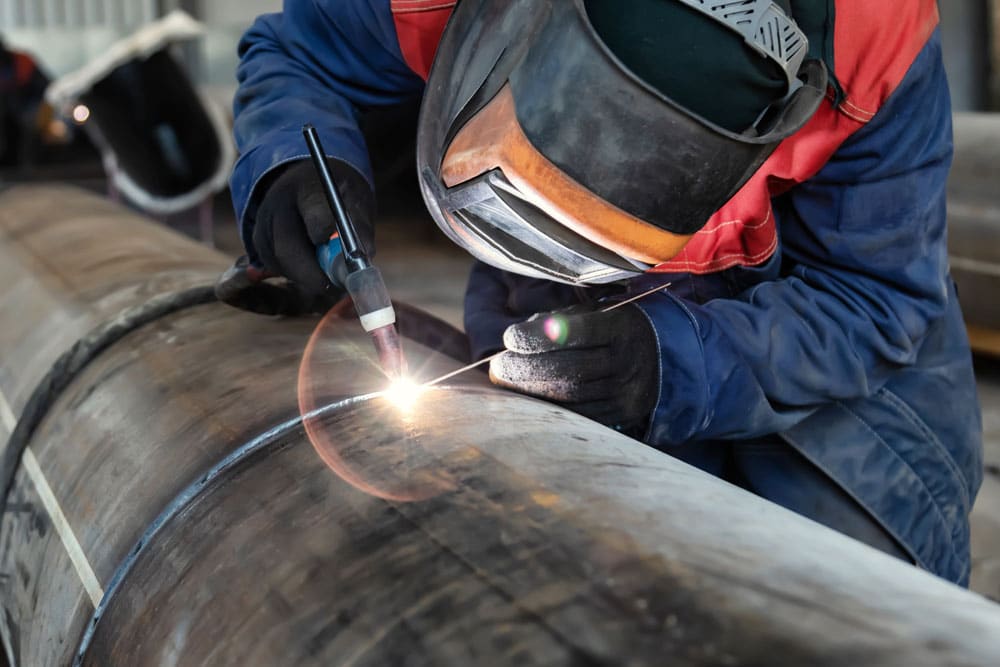

For those living in older houses or houses that have been refurbished without removing all the fittings, you might come across black iron pipe. For a long time, it was considered a top-tier option for gas lines and would even be used in water lines. It features a black exterior as per the name.
Since it’s not very common in the modern age, many people who stumble onto it are curious whether welding black iron pipe is possible. This question makes sense as most black iron pipes are designed a little like PVC pipe where they’re threaded at the ends to ensure they fit together easily. As such, if you look at the fittings in your house that incorporate this material, it’s hard to see any welded components.
Nonetheless, you can find out the composition, how to weld it, including the tools needed, and the risks of it all in the sections below.
Despite the naming, it may surprise you to find out that black iron pipe is actually steel rather than iron.
Difference Between
Trusted Source
Difference Between Iron and Steel | Difference Between
There are many differences between iron and steel. Primarily, iron is an element while steel is an alloy comprising of iron and carbon.
www.differencebetween.net
asserts that the latter is an element in the periodic table while the former is an alloy made from mixing iron with carbon.
The dark color on the outside of the metal isn’t painted onto it. Instead, it’s a result of iron-oxide forming on the outside of the steel during manufacturing. Nevertheless, the color is dark enough to warrant the name black iron pipe.
Galvanized pipes also consist mainly of steel. As such, you may be wondering what makes it so different from black pipe and why they’re priced differently. Additionally, galvanized pipes seem to be more common in today’s world compared to black iron pipes both in shops and in construction projects.
It all comes down to the coating on the metal. As we mentioned above, the coating on the outside of black iron pipe is iron-oxide. Most galvanized pipes also have a coating that forms when the steel is dipped into hot zinc. This makes galvanized pipes more durable, although they come at a higher price point as well.
One of the reasons why black pipe was so popular in the past is its heat resistance. This is why it was incorporated into sprinkler systems. However, it doesn’t perform too well against rust and corrosion. Galvanized steel, on the other hand, is quite resistant to corrosion. Finally, a galvanized pipe has a silver exterior which is not what you get with black iron pipe.
Now to the question of the day: can you weld black iron pipe? The simple answer is yes. However, welding is rarely ever that simple. It depends on the types of metals you’re trying to join to the pipe. For instance, if you think you can weld black iron pipe to brass, you’re wrong.
Also, welding black pipe to other types of metals is not generally recommended. It is possible to do, but the level of skill and knowledge needed to do it is well beyond the level of many hobbyists and beginner welders. There are so many things to incorporate into the process, such as electrochemical differences, solubility, melting points of the different metals, and more.
It would help if there was a black iron pipe welding table that included all this information, but unfortunately, there’s none. As such, you would have to tackle it on a case-by-case basis.
Nevertheless, if you’re welding the black iron pipe to other pieces of the same, it should be pretty easy to do, especially if you use the right welding processes. The same is the case if you’re connecting the pipe to another piece of steel.
You can use any arc welding process you deem fit, so there’s no need to debate the merits and demerits of MIG vs TIG welding in your head. However, if you don’t own an arc welding machine, users have recommended the Hobart 500559 as a reliable choice for hobbyists. It’s pretty affordable, works on standard household outlets, and offers both MIG and Flux-cored welding.
Since galvanized pipe is a lot more common, you may have come across it in your welding projects and had to deal with some of the risks. The most obvious of which is the toxic fumes released due to the zinc coating.
You may assume that you can relax when MIG or Stick welding black iron pipe and fittings just because it doesn’t incorporate the same coating. However, no welding process is ever truly risk-free. Something could go wrong and cause you bodily harm. Here are some of the risk factors you need to watch out for.
Just because there won’t be any fumes caused by a zinc coating doesn’t mean there won’t be any poisonous fumes when welding at all.
Any welding process is bound to release some gases and smoke, which is why it’s generally recommended that you do it in well-ventilated areas.
According to Occupational Health Trusted Source Welding Fume and Gas Exposure -- Occupational Health & Safety Welding fume exposure tends to be highly variable due to several exposure factors. ohsonline.com , one example of this is where TIG welding still produces nitrogen dioxide, nitric oxide, and ozone gases despite its small output of fumes. Consequently, wearing a mask to protect yourself, in addition to welding in a ventilated area, is a good idea.
Shock is another risk factor as you are dealing with electric currents. Damage to your equipment and having conductive elements around raise the risk of this even higher.
Lastly, there’s the risk of injury. It may be minimal, for instance, if a small piece of pipe falls onto your leg, or it may be something major. There are many possible scenarios, such as if you’re used to welding black iron pipes without any protective gear, then blindness or cataracts are two possible repercussions.
Ultimately, you’ll need to mitigate against these risks by wearing protective gear and practicing safety measures such as checking your equipment for damage every time you’re about to start a project. Finally, here’s the right way to weld black iron pipe.

Collect all the materials and tools you need for the project. These include a wire brush, work table, a clamping system for the pipes, welding gloves, welding helmet, rags, appropriate electrodes, and finally, an arc welder. Users recommend the Weldpro 200 since it will allow you to work with multiple welding processes. It’s also dual voltage and will work with whatever socket you have available.
Clean the black iron pipe and other metal with specific attention to the edges to be joined. This is where you use the wire brush and the rag.
Place the welding components on your worktable and clamp them in place. Finish up your preparation by ensuring you’ve taken all precautionary measures, including wearing your protective gear.
You need to complete a circuit while welding, and part of this involves attaching the grounding clamp to either the worktable if it is conductive or to the metals you’re welding. Follow this up by turning your welding machine on and adjusting the arc settings to match the project. Most modern welding devices come with instructions and charts on how to do this.
Create a few tacks to hold the metals together. You do this by positioning your arc at a few of the points where the metals meet. This will melt the two components, and by the time they cool down, they will be bonded.
Follow up by working your electrode around the seam in small circles to ensure even melting and bonding of the metals. Once done, leave the weld to cool.
Clean the weld. Your wire brush will again come in handy. You can then add paint as a finishing touch, although it may not be necessary depending on what you intend to do with the product.
Notably, in a seamless vs welded pipe comparison, the seamless option is the winner in terms of durability. However, it’s more expensive, and you can’t create seamless pipes in your home workshop. On the other hand, the equipment for welding black iron pipes is affordable and available for home use. As such, it may prove more viable to weld the pipe as compared to looking for the seamless alternative for some of your home projects and repairs. What you need to know to pull it off is already included in the sections above.